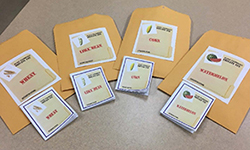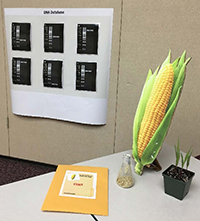Alyssa Koehler is an assistant professor and plant pathology extension specialist from the Department of Plant and Soil Sciences within the University of Delaware.
Science outreach activity: Plant Pathology Private Eye.
Type of event: Workshop.

Case files and the workbooks within. Each student received a workbook. We developed materials for watermelon, corn, wheat, and lima bean so that each small group had a different mystery. The groups all shared their findings with the larger group at the end of the activity.
|

Materials within one case file.
|

Case file and DNA Database poster. The gel images flipped up and revealed “Sorry not correct" or “Congratulations" messages and information about the disease.
|
Intended audience: K-12 students. The level of difficulty can be adjusted as needed.
Description of the activity: This activity was originally created for a STEM outreach event for 6th- to 8th-grade girls. Students were split into groups and received a clue describing a type of crop. Once they figured out their host, they went to the appropriate station to pick up their “case file," which included relevant pictures, workbooks, a fungal culture and infected plant, and the answer to their DNA band-size mystery in a sealed envelope. The activity booklet introduced the mystery, guided them through using a wooden microscope to look at some aspect of their pathogen (hyphae, sclerotia, etc.), and provided instructions on PCR and loading a gel to find out the DNA size of their organism. After practicing loading a gel, they opened their sealed envelope to find a preprinted gel image that they then matched to an image on a large poster to officially “solve" their mystery.
Materials needed for this activity:
- Host booklets (created for watermelon, corn, lima bean, and wheat).
- Petri dish, flask, or inoculated plant (something to offer a visual of the disease).
- Pictures of symptoms and diagnostic features.
- Sealed envelope with gel-band picture.
- DNA Database poster with flip-style images, so participants can match the picture in their sealed envelope with the correct pathogen gel band.
- Optional: Cardboard cutouts of hosts to have as the “home base" of the stations.
- Optional (depending on budget): Each microscope package included:
- Echo wooden microscope (cost $10 per scope; these come as a flat sheet, and students assemble their own microscope; a cell phone camera was used to take photos. In this activity, the microscope was a “goody" that the students were able to take home).
- Slides.
- Cover slips.
- Dropper bottle of water.
- Probe or forceps.
- For practicing loading a gel:
- Premade gel in a plastic storage container filled with water.
- Loading dye.
- Pipette.
- Tips.
- Container with water for gels or nearby sink.
- Paper towels.
For information regarding this event: The materials for this activity are available upon request from
Alyssa Koehler.
How will you modify or improve future offerings? The event went smoothly. The main challenge for hosting this event additional times has been COVID-related restrictions.
How many times has this activity been hosted? Once.
In total, how many participants have been in attendance? 65 students.
To have your science outreach activity or event featured in the “OPRO meets…" article series, please complete
this survey.
